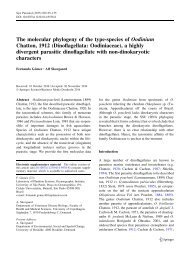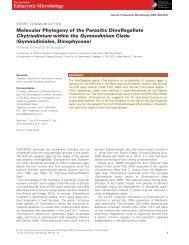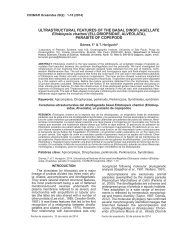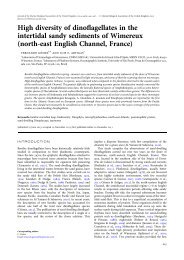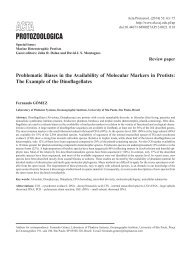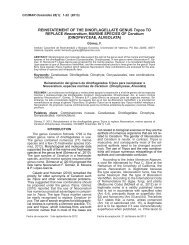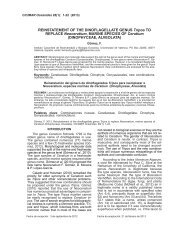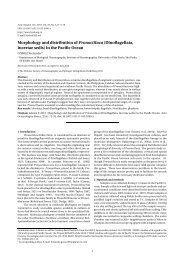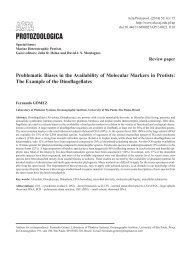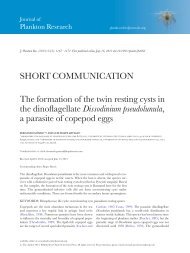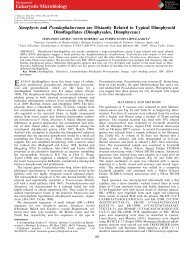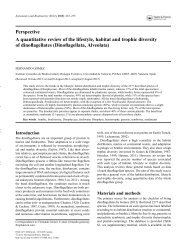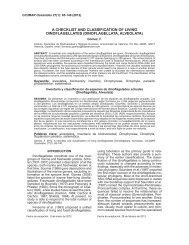Solenicola setigera is the first characterized memberof the abundant and cosmopolitan uncultured marine stramenopile group MAST-3
Culture-independent molecular methods based on the amplification, cloning and sequencing of smallsubunit (SSU) rRNA genes are a powerful tool to study the diversity of prokaryotic and eukaryotic microorganisms for which morphological features are not conspicuous. In recent years, molecular data from environmental surveys have revealed several clades of protists lacking cultured and/or described members. Among them are various clades of marine stramenopiles (heterokonts), which are thought to play an essential ecological role as grazers, being abundant and distributed in oceans worldwide. In this work, we show that Solenicola setigera, a distinctive widespread colonial marine protist, is a member of the environmental clade MArine STramenopile 3 (MAST-3). Solenicola is generally considered as a parasite or an epiphyte of the diatom Leptocylindrus mediterraneus. So far, the ultrastructural, morphological and ecological data available were insufficient to elucidate its phylogenetic position, even at the division or class level. We determined SSU rRNA gene sequences of S. setigera specimens sampled from different locations and seasons in the type locality, the Gulf of Lions, France. They were closely related, though not identical, which, together with morphological differences under electron microscopy, suggest the occurrence of several species. Solenicola sequences were well nested within the MAST-3 clade in phylogenetic trees. Since Solenicola is the first identified member of this abundant marine clade, we propose the name Solenicolida for the MAST-3 phylogenetic group.
Culture-independent molecular methods based on
the amplification, cloning and sequencing of smallsubunit
(SSU) rRNA genes are a powerful tool to
study the diversity of prokaryotic and eukaryotic
microorganisms for which morphological features are
not conspicuous. In recent years, molecular data from
environmental surveys have revealed several clades
of protists lacking cultured and/or described
members. Among them are various clades of marine
stramenopiles (heterokonts), which are thought to
play an essential ecological role as grazers, being
abundant and distributed in oceans worldwide. In this
work, we show that Solenicola setigera, a distinctive
widespread colonial marine protist, is a member of
the environmental clade MArine STramenopile 3
(MAST-3). Solenicola is generally considered as a
parasite or an epiphyte of the diatom Leptocylindrus
mediterraneus. So far, the ultrastructural, morphological
and ecological data available were insufficient
to elucidate its phylogenetic position, even at the division
or class level. We determined SSU rRNA gene
sequences of S. setigera specimens sampled from
different locations and seasons in the type locality,
the Gulf of Lions, France. They were closely related,
though not identical, which, together with morphological
differences under electron microscopy,
suggest the occurrence of several species. Solenicola
sequences were well nested within the MAST-3
clade in phylogenetic trees. Since Solenicola is the
first identified member of this abundant marine clade,
we propose the name Solenicolida for the MAST-3
phylogenetic group.
Create successful ePaper yourself
Turn your PDF publications into a flip-book with our unique Google optimized e-Paper software.
<strong>Solenicola</strong> belongs to <strong>uncultured</strong> <strong>stramenopile</strong>s <strong>MAST</strong>-3 201<br />
Flagellates. Leadbeater, B.S.C., <strong>and</strong> Green, J.C. (eds).<br />
London, UK: Taylor <strong>and</strong> Franc<strong>is</strong>, pp. 240–268.<br />
Buck, K.R., <strong>and</strong> Bentham, W.N. (1998) A novel symbios<strong>is</strong><br />
between a cyanobacterium, Synechococcus sp., an aplastidic<br />
prot<strong>is</strong>t, <strong>Solenicola</strong> <strong>setigera</strong>, <strong>and</strong> a diatom, Leptocylindrus<br />
mediterraneus, in <strong>the</strong> open ocean. Mar Biol 132:<br />
349–355.<br />
Cavalier-Smith, T., <strong>and</strong> Chao, E.E.Y. (2006) Phylogeny <strong>and</strong><br />
megasystematics of phagotrophic heterokonts (kingdom<br />
Chrom<strong>is</strong>ta). J Mol Evol 62: 388–420.<br />
Cuvelier, M.L., Ortiz, A., Kim, E., Moehlig, H., Richardson,<br />
D.E., Heidelberg, J.F., et al. (2008) Widespread d<strong>is</strong>tribution<br />
of a unique <strong>marine</strong> prot<strong>is</strong>tan lineage. Environ Microbiol 10:<br />
1621–1634.<br />
Díez, B., Pedrós-Alió, C., <strong>and</strong> Massana, R. (2001) Study of<br />
genetic diversity of eukaryotic picoplankton in different<br />
oceanic regions by small-subunit rRNA gene cloning <strong>and</strong><br />
sequencing. Appl Environ Microbiol 67: 2932–2941.<br />
Edgar, R.C. (2004) MUSCLE: multiple sequence alignment<br />
with high accuracy <strong>and</strong> high throughput. Nucleic Acids Res<br />
32: 1792–1799.<br />
Fryxell, G.A. (1989) Marine phytoplankton at <strong>the</strong> Weddell Sea<br />
ice edge: seasonal changes at <strong>the</strong> specific level. Polar Biol<br />
10: 1–18.<br />
Gastrich, M.D., Anderson, O.R., Benmayor, S.S., <strong>and</strong><br />
Cosper, E.M. (1998) Ultrastructural analys<strong>is</strong> of viral infection<br />
in <strong>the</strong> brown-tide alga, Aureococcus anophagefferens<br />
(Pelagophyceae). Phycologia 37: 300–306.<br />
Gómez, F. (2007) The consortium of <strong>the</strong> protozoan <strong>Solenicola</strong><br />
<strong>setigera</strong> <strong>and</strong> <strong>the</strong> diatom Leptocylindrus mediterraneus<br />
in <strong>the</strong> Pacific Ocean. Acta Protozool 46: 15–24.<br />
Gran, H.H. (1904) Diatomeen. Nord<strong>is</strong>ches Plankton Bot 19:<br />
1–146.<br />
Guillou, L., Chretiennot-Dinet, M.J., Boulben, S., Moon-van<br />
der Staay, S.Y., <strong>and</strong> Vaulot, D. (1999) Symbiomonas scintillans<br />
gen. et sp. nov. <strong>and</strong> Picophagus flagellatus gen. et<br />
sp. nov. (Heterokonta): two new heterotrophic flagellates of<br />
picoplanktonic size. Prot<strong>is</strong>t 150: 383–398.<br />
Guillou, L., Viprey, M., Chambouvet, A., Welsh, R.M.,<br />
Kirkham, A.R., Massana, R., et al. (2008) Widespread<br />
occurrence <strong>and</strong> genetic diversity of <strong>marine</strong> parasitoids<br />
belonging to Syndiniales (Alveolata). Environ Microbiol 10:<br />
3349–3365.<br />
Gunderson, J.H., Goss, S.H., <strong>and</strong> Coats, D.W. (1999) The<br />
phylogenetic position of Amoebophrya sp. infecting Gymnodinium<br />
sanguineum. J Eukaryot Microbiol 46: 194–197.<br />
Harada, A., Ohtsuka, S., <strong>and</strong> Horiguchi, T. (2007) Species of<br />
<strong>the</strong> parasitic genus Duboscquella are members of <strong>the</strong> enigmatic<br />
Marine Alveolate Group I. Prot<strong>is</strong>t 158: 337–347.<br />
Hasle, G.R. (1975) Some living <strong>marine</strong> species of <strong>the</strong> diatom<br />
family Rhizosoleniaceae. Nova Hedwigia Beih 53: 99–<br />
140.<br />
Hasle, G.R., <strong>and</strong> Syvertsen, E.E. (1997) Marine diatoms. In<br />
Identifying Marine Phytoplankton. Tomas, C.R. (ed.). San<br />
Diego, CA, USA: Academic Press, pp. 5–385.<br />
Jobb, G., von Haeseler, A., <strong>and</strong> Strimmer, K. (2004) TREEF-<br />
INDER: A powerful graphical analys<strong>is</strong> environment for<br />
molecular phylogenetics. BMC Evol Biol 4: 18.<br />
Kolodziej, K., <strong>and</strong> Stoeck, T. (2007) Cellular identification of a<br />
novel <strong>uncultured</strong> <strong>marine</strong> <strong>stramenopile</strong> (<strong>MAST</strong>-12 Clade)<br />
small-subunit rRNA gene sequence from a Norwegian<br />
estuary by use of fluorescence in situ hybridizationscanning<br />
electron microscopy. Appl Environ Microbiol 73:<br />
2718–2726.<br />
López-García, P., Rodríguez-Valera, F., Pedrós-Alió, C., <strong>and</strong><br />
Moreira, D. (2001) Unexpected diversity of small eukaryotes<br />
in deep-sea Antarctic plankton. Nature 409: 603–607.<br />
Luo, W., Li, H.R., Cai, M.H., <strong>and</strong> He, J.F. (2009) Diversity of<br />
microbial eukaryotes in Kongsfjorden, Svalbard. Hydrobiologia<br />
636: 233–248.<br />
Margalef, R. (1969) Composición específica del fitoplancton<br />
de la costa catalano-levantina (Mediterráneo occidental)<br />
en 1962–1967. Investig Pesqueras 33: 345–380.<br />
Massana, R., <strong>and</strong> Pedrós-Alió, C. (2008) Unveiling new<br />
microbial eukaryotes in <strong>the</strong> surface ocean. Curr Opin<br />
Microbiol 11: 213–218.<br />
Massana, R., Guillou, L., Diez, B., <strong>and</strong> Pedrós-Alió, C. (2002)<br />
Unveiling <strong>the</strong> organ<strong>is</strong>ms behind novel eukaryotic ribosomal<br />
DNA sequences from <strong>the</strong> ocean. Appl Environ Microbiol<br />
68: 4554–4558.<br />
Massana, R., Castresana, J., Balague, V., Guillou, L.,<br />
Romari, K., Gro<strong>is</strong>illier, A., et al. (2004) Phylogenetic <strong>and</strong><br />
ecological analys<strong>is</strong> of novel <strong>marine</strong> <strong>stramenopile</strong>s. Appl<br />
Environ Microbiol 70: 3528–3534.<br />
Massana, R., Campo, J., Dinter, C., <strong>and</strong> Sommaruga, R.<br />
(2007) Crash of a population of <strong>the</strong> <strong>marine</strong> heterotrophic<br />
flagellate Cafeteria roenbergens<strong>is</strong> by viral infection.<br />
Environ Microbiol 9: 2660–2669.<br />
Moon-van der Staay, S.Y., De Wachter, R., <strong>and</strong> Vaulot, D.<br />
(2001) Oceanic 18S rDNA sequences from picoplankton<br />
reveal unsuspected eukaryotic diversity. Nature 409: 607–<br />
610.<br />
Moreira, D., <strong>and</strong> López-García, P. (2002) Molecular ecology<br />
of microbial eukaryotes unveils a hidden world. Trends<br />
Microbiol 10: 31–38.<br />
Moreira, D., <strong>and</strong> López-García, P. (2003) Are hydro<strong>the</strong>rmal<br />
vents oases for parasitic prot<strong>is</strong>ts? Trends Parasitol 19:<br />
556–558.<br />
Not, F., Valentin, K., Romari, K., Lovejoy, C., Massana, R.,<br />
Tobe, K., et al. (2007) Picobiliphytes: a <strong>marine</strong> picoplanktonic<br />
algal <strong>group</strong> with unknown affinities to o<strong>the</strong>r eukaryotes.<br />
Science 315: 253–255.<br />
Not, F., del Campo, J., Balague, V., de Vargas, C., <strong>and</strong><br />
Massana, R. (2009) New insights into <strong>the</strong> diversity of<br />
<strong>marine</strong> picoeukaryotes. PLoS ONE 4: e7143.<br />
Park, J.S., Cho, B.C., <strong>and</strong> Simpson, A.G.B. (2006) Halocafeteria<br />
seosinens<strong>is</strong> gen. et sp. nov. (Bicosoecida), a halophilic<br />
bacterivorous nanoflagellate <strong>is</strong>olated from a solar<br />
saltern. Extremophiles 10: 493–504.<br />
Patterson, D.J. (1989) Stramenopiles: chromophytes from a<br />
prot<strong>is</strong>tan perspective. In The Chromophyte Algae: Problems<br />
<strong>and</strong> Perspectives. Green, J.C., Leadbeater, B.S.C.,<br />
<strong>and</strong> Diver, W.L. (eds). Oxford, UK: Clarendon, pp. 357–<br />
379.<br />
Patterson, D.J., <strong>and</strong> Zölffel, M. (1991) Heterotrophic flagellates<br />
of uncertain taxonomic position. In The Biology of<br />
Free-Living Heterotrophic Flagellates. Patterson, D.J., <strong>and</strong><br />
Larsen, J. (eds). Oxford, UK: Clarendon Press, pp. 427–<br />
476.<br />
Pavillard, J. (1916) Flagellées nouveaux épiphytes des<br />
diatomées pélagiques. C R Hebd Seances Acad Sci 163:<br />
65–68.<br />
© 2010 Society for Applied Microbiology <strong>and</strong> Blackwell Publ<strong>is</strong>hing Ltd, Environmental Microbiology, 13, 193–202



